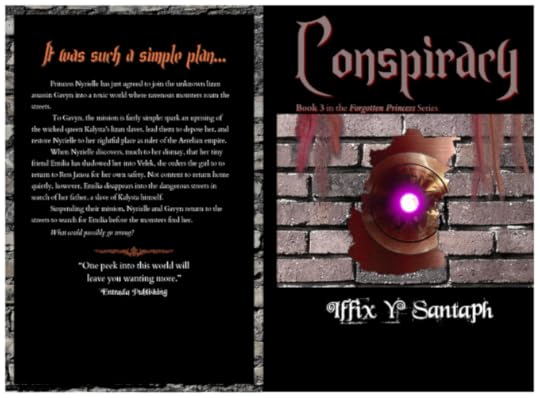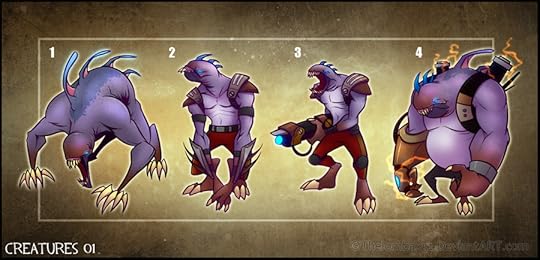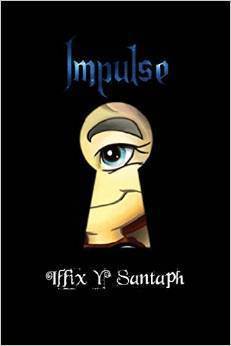Iffix Y. Santaph's Blog, page 2
December 16, 2015
Writing the Opposite Gender…
(Cringe. Is he really going to talk about that one?)
Some have wondered about the challenge of writing the opposite gender. It can be a challenge. A writer generally doesn’t set out to offend his audience. Writing isn’t quite like other forms of entertainment. Actors, for example, look at any sort of publicity as good publicity. When a writer is first starting out, a negative reputation can sink a hoped for career. But in this case, overthinking can be hazardous.
It is generally accepted that you will have characters of both genders in your work. However, a character should be more than his or her gender. In other words, if the only reason for the character is so that you have someone of the opposite gender, it’s a mistake. As with other concerns that have been addressed in this blog, really understanding your character as a person is a key to solving this problem.
If the character comes to life in your imagination, you generally won’t misstep. More important for your character than being true to her gender is being true to herself. We live in a world where social stereotypes have been cast to the winds. Women and men share roles in society, and should interchange roles in literature.
I wanted to make mention of a powerful tool I found some time ago. It is called the Bechdel test. To some, the test is relatively well known. But for those who have never heard of it, the Bechdel test asks a question of whether a work of fiction (book, tv show episode, movie, or otherwise) has at least one scene where two women are talking to one another not about a man. This is a very good test, as it actually shows a depth of character. The same might be said for a work of fiction which predominantly features female characters. Are the men pigs with their minds in the gutter? Whenever men are present, is it so they can shoot things? (And if it is, do the women also shoot things?)
When writing the opposite gender, if the character has depth, even if the character is very different from most of her gender, your audience likely won’t grumble. These subtle differences, if true to your character, may intrigue your audience rather than put them off. So try to think of your character on a deeper level, and then write what comes naturally.
Another secret I have found is to really listen when my audience speaks. I find when we learn from one another, our writing improves greatly. That said, what secrets have you found to become more comfortable writing characters of the opposite gender?


December 12, 2015
Making Your Story “Better”
Let me preface this article: I’ve been preparing for the movie of the year, as so many other geeks are. I have been re-watching Episodes 4-6, the good versions. Why do I say “good versions”? You might remember that these movies have gone through several re-releases over the past 30 years. Some made the story better. Some ruined the movie for fans everywhere. I’m not here going to spell out what made the difference. (The fans know what I’m talking about.) But here’s a question to ponder. As writers, we have the opportunity to make our stories better before our readers ever see them. How can we make certain that a brilliant new idea is leading down the right road? It’s really not complicated. As writers, we need to have an understanding about who our characters really are.
When deciding to change a scene, consider what about your character led to the scene you originally created. If the character said something a certain way, is this how you imagine her? Or if the character decides to try a different action, is it because “this action is cooler”, or is it because “this action is truer to the character”? (Interestingly, any action that is truer to the character actually does become cooler. Whereas doing something for the sake of awesomeness may actually upset your audience. Does that seem strange to anyone else?) Also keep in mind that whatever changes you decide to make may have major repercussions later in your story, as your character draws from a different knowledge base than he would have had initially. If you decide to “make this action cooler” are you prepared for a major overhaul on your plot?
Keep in mind that a subtle change in your character may make different inferences, thus making a character’s growth less or more remarkable. For example, take the cringe-worthy scene in a Mos Eisley Cantina where it was decided that “Han’s such a great guy he couldn’t possibly have shot Greedo first.” (GROAN!) The audience knows that Han comes from a nasty beginning and becomes a really great guy when he shows up to help Luke destroy the death star. And this change was a marvel, one which fans loved! By stopping Han from shooting first, this subtle change robbed Han of the chance to make remarkable character growth. The point? A subtle change in where your character came from may greatly impact where said character is going, and how the audience will feel when he gets there.
This is not to say that changes shouldn’t be made. I have made several. In my most recent work, I was struggling to decide who the villain really was and I reached a very different conclusion than I started with. I knew that for the character in question to make the sort of drastic changes I had planned, I needed to give a solid basis for said change, one which was not presented earlier in the series. (Someday, I may share my alternate plot with you, though I think it would be best to release Conspiracy first, which should take place within the week.) Ultimately, I let the characters direct the action, and I found the results were satisfying.
As a writer, I write much of my work free-hand without a preconceived outline. That being said, an outline can help with some of the planning and can prevent you from going down the wrong road. But there are factors in play over the course of a full draft that may not have occurred to you while writing an outline. If you realize, while writing a draft that you are drawing further and further away from your outline, don’t assume you are doing something wrong. I have come to believe that when a story happens differently than I expected, the character has taken over, and since it is the character’s story, perhaps this is what I want to happen. The same may be true for you. Consider revising the outline based on where your character has gone. You may really like the results.
If you are being 1) truer to your character, definitely consider making the change. Especially is this so if 2) you are willing to do a major overhaul. Your fans may really appreciate this effort, even though they may never know about it.
Another key I have found to making stories better is to listen to my audience and work together. I believe that when we work together all of our stories become better as a result. That said, what keys have you found to making your story better? Please feel free to leave a comment below.


November 30, 2015
Requesting Feedback/Cover Reveal: Conspiracy
Unfortunately, dear readers, do to circumstances beyond her control, my cover artist had to withdraw. I know that I don’t have much time before my deadline (as I promised a Fall delivery date on Conspiracy), so I am valuing any feedback you are willing to share. I have put my knowledge of Gimp 2.0 as well as some free resources to good use. This is the result. It is a cover reveal, and I am content with it if it will satisfy you. After all, it is your investment. Please share any feelings. Even words like “gag” and “repulsive” will work so long as they’re honest.

From personal judgment, the back page font feels a bit too small. I’m going to adjust that. In the meantime, this is another version to chew on.



November 16, 2015
Writing an Epic Battle Sequence
Writing an Epic Battle can be tremendously difficult if you don’t know what you’re doing. I suppose that can be said for a lot of different aspects of a story. I learned this particular lesson the hard way. This article is more for my own personal memory aid to look back on as I write Epic Battles in the future, though if this helps someone else along the way, all the better.

Going in, I already knew what I wanted to achieve. I wanted to write the next great movie action sequence… The first mistake I made was treating a book like it was a movie. If you’re anything like me, there’s something thrilling about this sort of action on the big screen, whether the Avengers are fighting the many replicas of Ultron, or a team of inexperienced fighter pilots are trying to destroy the Death Star, that just awakens your imagination. And then you’re totally thrilled at the prospect that we, as authors, get to write that sort of thing. And, in some respects we can, but there is something distinctly visual that cannot be achieved with words alone.
You will find that many successful authors avoid writing fight scenes. You will find that many hopeful readers will actually skip the fights in your books to get to the “good part”, even if you thought the battle was the “good part”. You will find that many well-intentioned authors who write exceptional action sequences, will discourage others from doing so.
They say it can’t be taught. They’re right. It requires a fair amount of intuition. You cannot teach a hopeful writer to craft an action sequence any more than you can teach a hopeful teen with a sharpened pencil and a notebook to write a meaningful poem. (I say this because, as a teen, when asked to write meaningful poetry, I wrote a poem about classmates who wore too much perfume. [A sample of said poem? Alright…]
I grieve that you reek putridly
In that stink cloud how do you see?
I tried to tell you, but gagged far more
Then taped this to your locker door.
That poem didn’t impress my English teacher, though apparently my old math teacher still has it hanging on the wall in his classroom after 12 years. Thanks for the encouragement, Mr. Harvey!)
Getting back into the part of this article that’s actually helpful (and leaving nostalgia behind), I discovered a few tricks in this endeavor that made the battle scene work for me. And though you will indeed have to figure out the rest for yourself, perhaps this might be some additional advice.
First off, it can be intimidating to write an action sequence. But no matter how much reading of silly books about fight scenes you delve into, you still have to get the words into your word processor yourself. Can listening to the right kind of music help? Possibly. Can it also delay your work while sifting aimlessly through Pandora playlists? Certainly. Can you look to the greats for their advice? Advice on this sort of thing is plentiful. But if you’re still searching for advice after you’ve read the greats (and that’s a real possibility as you’re reading an article by me), and reading through the stories that have truly epic fight scenes for inspiration, you must consign yourself to either of two options. First, you will give up this pursuit and try writing comedy stories about teddy bears and trains for toddlers instead. (Check!) Second, you will grit your teeth and get down to the business of writing your heart out. And trust me, when you finally get past the “can’t do it” to the “can”, it may very well become easier than you expected.
To begin your fight scene, it helps to know what the characters are fighting about, and having an idea of what they will look like afterward. If your heroes are still standing without a scratch on them while your villains are in a pile on the floor, you probably did something wrong. There’s a good chance that someone will lose something they cared about and planned to use later. (Visualize that. Then figure out how it happened and work backward.)
Next, put your imagination to work. As with any action your character takes in a story, you cannot push aside characterization with an action scene. So you must really see your protagonist and supporting characters do what you are writing about them. Trust your imagination. If your protagonist is about to get creamed in the fight, don’t make him the hero he can’t be. Then, consider how you can use your character’s strengths to gain the victory. For example, perhaps your character doesn’t know a pommel from a rain guard, in which case, giving him a sword will be useless. Perhaps he doesn’t know how to turn off the safety on the rifle he’s been given. Not that you don’t give him a blade or a rifle anyhow, but if he’s incompetent, this should be readily evident.
It can be a lot of fun to pit your character against another he has no real shot of beating, and it makes your readers cringe, which is actually a positive response. There is something thrilling about a hero backed into a corner with no way out. But, this likewise has two outcomes. Either your character will reach a tragic end or find another solution your reader hadn’t thought of.
Usually, it is best to find something about your character’s unique skill-set that can get the job done, rather than relying on outside interference. However, if your character must rely on outside interference, make certain your audience is aware that the outside interference is plausible. Deus Ex Machina, the rescue from nowhere, kills your story and your reputation as a writer. Even subtle hints at the possibility of outside interference work well. Another possibility that works well, if you must use outside interference in your story, is to make the rescue lead the character into an even worse situation than she was in already. Have the outside interference come from the villain himself, for example. The hero is facing a thug when suddenly a gigantic monster races in, bites the thug in half and licks his lips. Now the peril is just as real, but the problem is of a different nature. Perhaps your character has a stick of bubble gum in her purse. The thug doesn’t like bubble-gum, but the gigantic monster catches the gum in his teeth, chews it until his mouth is stuck shut, and your hero makes her escape. (There could be worse plots.)
Another challenge of the epic battle is too many characters to control. This is rather simple. Consider which of your characters are important enough to merit their own scene in the battle, and write these parts. Use your additional heroes and villains to season the scene, adding twists and turns to the conflict. (It is best if your supporting heroes and villains are quite competent, so that your reader doesn’t need to wonder about them while fully engaged with your protagonist.) If you don’t focus on too much at once, the scene becomes far easier to write. If something your supporting character is going to do merits a paragraph, have this character cut across your hero’s path while doing his heroic deed. Your audience will get a glimpse of his presence without losing sight of the focus character.
These are just a few of the tricks I’ve begun to unearth in my pursuit of an epic battle. (You might naturally find that I used these tricks in my Forgotten Princess series.) Perhaps you have found other tricks of the trade. When we learn from one another, all of our works become better as a result. Therefore, what have you found that works for you? Feel free to share below.


November 7, 2015
Writing Sad
Writing a sad passage in a story can be a tremendous challenge. I’ve recently discovered that this is because the vast majority of us have very little desire to feel sad. Some time ago I wrote about capturing the five stages of grief when dealing with the loss of characters in fiction. The first stage of grief is denial. Some confuse this phase. Denial isn’t a refusal to accept that something bad has occurred. Often we’re fully aware when a tragedy happens in our lives. Rather this stage of denial is when a character denies himself or herself the right to feel anything about the tragedy. We hide those feelings because we don’t want to feel pain. So, naturally, if we don’t want to feel real pain, we certainly don’t want to feel an imaginary pain. So why write it to begin with?
Pain is humanizing. From the first time you got sick, you’ve known what pain felt like. Pain is a natural part of life. So if a character doesn’t feel such losses, the character becomes harder to relate to. On the other hand, there is a certain beauty about being able to express oneself well, even in words that might bring tears to our eyes. I once read this statement about a character who had in effect proven himself traitor to his best friend. It gave the idea that this was the worst moment of the worst day of his entire life. And that idea was so vivid, I felt the tears welling up. It was a simple comment, yet I could identify with the character. I felt closer to him because he was human.
What tricks of the trade will help you to write sad? I recently asked this question to my writing group. One of the most significant cues that a lot of the writers identified with was playing sad music quietly in the background while writing. I tried this, and it had a significant impact. But then, I wondered if I was sad because of the music or whether I had really achieved a degree of sadness in my prose. I will admit that the prose did improve, slightly. But we’re not going to tell our readers, “Okay, play a sad song while you’re reading this part of my book and you’ll get it.” Whether they decide to feel sad should come, not from another artist, but from us, the authors who choose to write sad.
I looked a little at composition and considered if there were things I was doing that could bring about the sad effect. What did I find? Little things: For example, whenever possible, while writing a passage, endeavor to mention the impacted character by name. Titles and noun phrases like “the boy” are actually distancing. And that makes sense in a psychological way. After all, how close can you be to someone before you know his name? In some ways, a tragic event that happens to a single event can have greater impact on us than a tragic event that happens to millions, because when we can identify the person, we can build a degree of attachment.
Another trick of the trade is to use flashbacks well. I asked this same group how important the details were when writing a piece of fiction. In certain circumstances, the details hardly seem to matter. But when you’re evoking an emotion in your character, the details make a big difference. The character needs to feel himself in the moment, as if it were crystal clear. This doesn’t mean every aspect of a scene will make it sadder–too much can be detrimental–but don’t skimp on the details.
Repeating dialogue may also help or hinder the person experiencing loss. I recently was working on a scene where a particularly troubled character was coming to grips with playing a part in a bad decision that cost his friend’s life. This character repeatedly echoed the phrase, “I killed him. I killed him.” In some instances, that repetition of phrase can be helpful. I found, though, that it wasn’t adding to the scene as much as I hoped it would. But here’s another slant. I took this last repeated phrase, and tweaked it. “I killed him,” he said, “I killed you. I’m so sorry. I killed you.” When you think of that scene, the character is now visualizing the one he killed as though talking right to him. You can imagine his grief on another level.
These are just a few of the tricks I have begun to unearth when writing sad. But perhaps you have other tricks that bring out the sad in your scenes. Because our stories improve greatly when we open ourselves to the possibility of really learning from others, I would love to hear from you: What keys have you found to evoke sadness in your readers?


October 11, 2015
Updates
A sincere apology for not keeping up regularly with this site as well as an author should. I have been deeply involved in the final editing of Conspiracy. The struggle is, because the world is so vivid, I often see details I missed as I’m editing that take a bit of reconstruction. I have rewritten the ending of this work more times than I can recount. (I don’t keep count. It wouldn’t be very encouraging.)
What can I tell you about Conspiracy? As mentioned at the conclusion of Deception, this book takes a different turn and references the gwalflings only briefly. (Don’t worry. Their story looks to be coming together nicely as well.) It will feature a few characters that until now have only been in supporting roles: the lizan Gavyn, Jarvik and Beltros, in addition to the human prince Jasper.
This represents part of an effort to expand this series in additional directions. I know that I will not bring every side-plot to a conclusion with this book, and I am aware that Retrospect will not largely feature many of the characters I have been working with in Conspiracy. This will likely result in additional short stories to be added to the site, when I can find the time to develop these.
In genre, the story is Epic Sci-Fi (think Lord of the Rings with robots) though I am endeavoring to keep it novella length. I am also attempting to release the books in such a way that each new book is for a slightly more mature audience. (Don’t worry. These books are, and will remain, wholly void of erotic scenes and foul language.) Conspiracy will take on a slightly darker, edgier and more complex story line, and will be my first true YA addition to the series, recommended for ages 13 and up.
Within the next week or so, I will be running this story through its final paces, and I will be submitting it to my selected artist for inspiration for cover artwork.I will add the cover image here as soon as it is available. For now, a teaser, as originally created by artist Yanissa Bumroongrachahirun.
(1) The queen Kalysta discovered these dangerous predators from a wild jungle planet called Qle’tuum. (2) She began to mutate them. (3) She programmed their minds with all sorts of details about the galaxy including a significant amount of reconditioning to be her army. (4) To make them even more dangerous, she used her scientific knowledge to have a machine called an Exo-gizer created.

I would like to speak a moment about Yanissa’s artistry. Back when I was originally envisioning this world, I found a series of very talented artists on DeviantArt. (Refer to my on-site art gallery.) Though many refused due to their work on other projects, I asked Yanissa if I could use some of her artwork as inspiration for this world I was building, a world that was then loosely based on a classic Brothers Grimm fairytale. And Yanissa surprised me perhaps a week later with brand new artwork that essentially helped me to solidify the evil queen in my own mind. Were it not for great artists like Yanissa, this story would not be nearly as easy to tell. She and the many other talented artists who worked with me on this vision are the reason I continue to write. Though I have not found tremendous success as an independent author, their story deserves to be told. And I will continue to do my part to draw attention to their artwork, for which I will always be grateful.


August 29, 2015
Apologies for an oversight…
Dear readers,
I wanted to apologize. I recently had a fellow author and reviewer show me the error of my ways.
I had hoped that Kindle would have taken more of an interest in making sure their product was user friendly for authors, so as to get you dear readers a quality product.
While I can vouch for the quality of Deception as a story (this fellow author confirmed that the story was well written) unfortunately, the formatting issues with KDP were catastrophic. (Effectively, the paragraphs were horribly broken, making the text unreadable.)
I have been bound to a 3 month contract (which ends in September) to sell my e-book with them (unless it is taken from the market). If I can find an audio-book editor with a credible file conversion, I will perhaps return my e-books to the market. However, at this time, I have opted to cease the sale of digital copies of Deception. I hope this doesn’t inconvenience anyone interested in reading the book. And again, I wish to extend my humble apologies.
Sincere regards,
Iffix Y Santaph


August 3, 2015
Roots
Question inspired by Samuel Friedman on Goodreads.com:
Have you ever discarded a completed manuscript?
I have been writing for more than 20 years. I have not been working on Forgotten Princess for nearly that long. In fact, I’ve only been working on this concept for a little over three years. So what came before?
My first completed novella was “What I Did During Summer Vacation” and was completed when I was thirteen, and involved (ironically enough) two kids on an intergalactic journey to return an alien to his parents. (I wrote this story primarily in first person. It was why I claim to have imaginary friends into my teen years. I don’t regret this.) That initiated a series of 17 novellas written over the course of the next four years. The series featured super spies, mysterious gems that granted ultimate power, multiverse jumping, wormhole travel, a shapeshifting villain and a wide assortment of other geekiness. My first romantic arc in a story involved a heroine who could cure poison with a kiss but who lost the ability while the poison remained in her system nearly killing her.
In my senior year of high school, I wrote two musical stage plays and a series of short spin-offs. The hero was a fourteen-year-old boy with an overactive imagination who was killed in a car accident on the Brooklyn bridge and a fourteen-year-old girl whose heart collapsed unexpectedly while she was descending a staircase to a New York City subway. Her heart was replaced by his, and she entered his imaginary world while she was in a coma. The boy was a prince, and she became a princess, and they both lived happily ever after, after deposing an evil emperor.
I grew tired of writing musicals and returned to sci-fi novellas. I experimented with a four-part family saga called Star Frost. Here I returned to the idea of a shapeshifting character, this one part of a family of thieves. He was a hapless charlatan with a love of playing Bluegrass music, and when he was told he might be exiled if he could not gain the affections of a princess, he actually did so, not by deception but with a bluegrass banjo.
I then wrote a thick novel based on a premise that when humans (in the distant future) journey out into the galaxy, they cross paths with the markedly intelligent dinosaurs who reached the new galaxy first. The confrontation sparked a war won by the humans when Admiral Onyx Breckett discovered the ability to move faster than light. When, later, his enemy caught up with him, he was separated from two twins who wound up on opposite sides of the next war. This war was the subject of the Dark Star Chronicles. This volume was written in multiple first person epistolary accounts.
Among other writing projects I’ve written a wide variety of poetry, and I have attempted boardgame and RPG design.
These are my roots, my history, which goes to show, not every idea is worth publishing, but we can learn a lot from writing a lot and hone our craft. I may yet return to some of these ideas in the future, but I am glad I waited and stuck with it until Forgotten Princess.
What about you, dear writers? What manuscripts have you written for the sake of learning craft which continue unpublished? And what led you to take the leap to publishing?


August 1, 2015
Quantity Vs Quality
I have been contemplating this moral dilemma for the past few months. I have said, in recent times, that I encourage young ones especially to hold off from self-publishing just because it is the easy way to get their stories out there. You may wonder, why do I self-publish my own work while at the same time discouraging self-publishing? What is the difference between believing your stories are ready and knowing they are? And, if you know your story is ready, won’t an existing agent or publisher agree with you? These are big questions. But what do they have to deal with the theme?
I spoke with an eager young writer the other day who told me she planned to publish a 12 book series. When I attempted to read her first book, which has in fact already been published along with a sequel, I was frankly saddened. The writer had clearly made no efforts to edit her work. When I pointed out this simple fact–if you don’t write quality, quantity won’t matter–she was upset, to say the least. And considering she had also been a fan of my work, I think I shrunk my fan-base.
Let’s go back, for a moment, to why young ones shouldn’t publish their works. At a certain age, you are so excited to be a writer, you may not realize that editing is part of the job description. Editors are very, very expensive, for someone first starting out and hoping to make a breakthrough. I am not a firm believer that they are strictly necessary, as long as you make it your aim to know as much as possible about editing. I was commended recently–even though the overall tone of the review had been negative–for putting a solid effort into self-editing. But you should know, at the age when I was most eager to enter this industry, I truly believed I wrote a “clean first draft”. Any author who carries this idea around in his head is fooling himself. And since English classes and writing classes are still being taught in colleges around the country, it is reasonable to say that most teens don’t know enough to approach writing professionally yet. (Alright, there are a few Christopher Paolini types in the world, so I will give them my nod of approval, though certainly these young ones already know the importance of good editing, or they would not have come so far.) Looking back now on those “clean first drafts” I used to write, I am tremendously overjoyed that I didn’t send a series of works full of typos out into the world.
So what makes me so confident that publishing the Forgotten Princess series myself is such a good idea? Seriously? I’m not. As stated before, this is a moral dilemma. You see, I want to find that agent or publisher who believes in my work as an author. But these days, agents seek out potential authors who have an already established platform. In other words, they want you to sell your work yourself first; then they might represent you. So how is a writer supposed to get a publisher without published work? True, they suggest writing articles for magazines. But if you write a particular niche of fiction, magazines are scarce. I considered writing about writing (it is one of my few specialties in life), but if you attempt to publish an article about writing when you are not a published author, your credibility disappears.
The cold truth is that one can never really know whether his writing is ready for publishing. And that brings me back to the theme. It is best to build credibility with quality works–even if achieving quality is a lengthy, painstaking process–because having others argue about the quality of your work is greatly preferred to their silent agreement that you have made a big mistake. By all means then, strive for quality at any phase of your life and you will have great reasons to believe in yourself, which is a very good place to start.
Since I encourage others to share insights, as a wonderful way for us to learn from one another, I invite your comments regarding any of the above issues.


July 18, 2015
Book Review: Impulse
Thanks for your sincere feedback Sam. It really is appreciated. I’m sorry you didn’t enjoy the experience. I will continue to hone my craft in the future.
 Originally posted on Books and Branding :
Originally posted on Books and Branding :

Happy Independence Day weekend for all you Americans!
If you missed my author interview with Iffix Santaph over his debut novella, Impulse, check it out here.
As promised, here is my review of the novel, which I received in exchange for an interview and review. Like last time, I’ve divided into five categories, and each was worth 0, 1, or 2 points. Scored on a scale 0-10.
Plot (semi-spoiler alert): The reader is introduced to the gwalf, human-like creatures who live in the city of Trounador. Jendra is the main character and heroine of the novel. She and her friend Leon discover a human body which is unconscious at the start of the novel, and they want to find a way to find out where the human is from. Together with Leon’s cousin Toby, they search for a way to help the alien.
To do this they must dodge obstacles, like…
View original 690 more words








